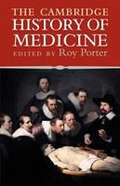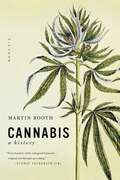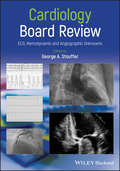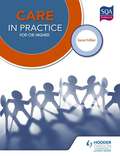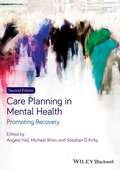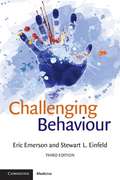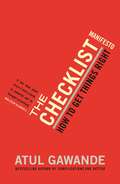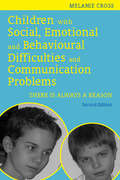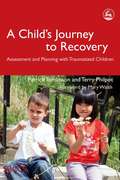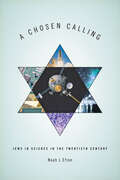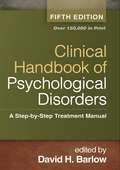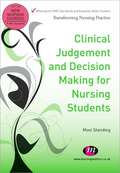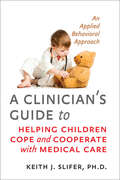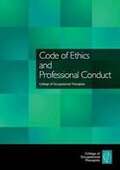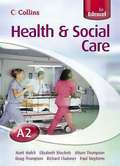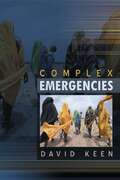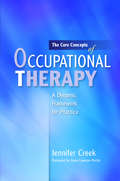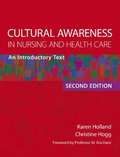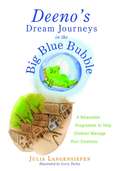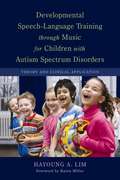- Table View
- List View
The Cambridge History of Medicine (PDF)
by Roy PorterThe Cambridge History of Medicine, first published in 2006, surveys the rise of medicine in the West from classical times to the present. Covering both the social and scientific history of medicine, this volume traces the chronology of key developments and events, while at the same time engaging with the issues, discoveries, and controversies that have beset and characterized medical progress. The authors weave a narrative that connects disease, doctors, primary care, surgery, the rise of hospitals, drug treatment and pharmacology, mental illness and psychiatry. This volume emphasizes the crucial developments of the past 150 years, but also examines classical, medieval, and Islamic and East Asian medicine. Authoritative and accessible, The Cambridge History of Medicine is for readers wanting a lively and informative introduction to medical history.
Cannabis: A History (PDF)
by Martin BoothTo some it's the classic gateway drug, to others it is a harmless way to relax, or provide relief from pain. Some fear it is dangerous and addictive, while others feel it should be decriminalized. Whatever the viewpoint, cannabis incites debate at every level, and the effect it has on every corner of the globe is undeniable. In this comprehensive study, Martin Booth crafts a tale of medical advance and religious enlightenment; of political subterfuge and law enforcement; of cunning smugglers, street pushers, gang warfare, writers, artists, and musicians. And above all, Booth chronicles the fascinating process through which cannabis became outlawed throughout the Western world, and the effect such legislation has had on the global economy.
Cardiology Board Review: ECG, Hemodynamic and Angiographic Unknowns
by George A. StoufferAn accessible and engaging review of board exam essentials Cardiology Board Review lays the groundwork for board exam success with its instructive and easy-to-read explanations of the pathophysiology, diagnosis, and treatment of patients with cardiovascular disease. Breaking topics down into case 'unknowns,' this innovative revision aid provides examples of everyday cardiological issues and then explains how best to address the problem at hand. All content is complemented by clinical images and illustrations, as well as helpful summaries and key points. Featuring 56 different cases, this essential text: Places learning in a practical context. Information about disease states is presented in case-based format which leads to better retention. Covers topics including congenital heart disease, coronary artery disease, cardiomyopathies, valvular heart disease, arrhythmias, heart failure, peripheral vascular disease, and more Designed to present important concepts and information in a unique way to complement textbook learning Features electrocardiograms, angiograms, and pressure tracings Is applicable to those working towards certification in Cardiovascular Disease from the American Board of Internal Medicine or preparing for board examinations in other countries Is also suitable for those requiring MOC recertification Features cases on aortic insufficiency, atrial fibrillation, Brugada syndrome, carotid artery disease, myocardial bridging, congenital heart disease, electrolyte abnormalities, apical HCM, mitral regurgitation, RV outflow tract tachycardia, pulmonary hypertension, arrhythmogenic right ventricular dysplasia, aortic stenosis, atrial myxoma, atrial tachycardia, pulmonic insufficiency, Takotsubo, tricuspid regurgitation, Wolfe-Parkinson-White syndrome, pulmonic stenosis, coronary anomalies, ECG changes of hypothermia, endocarditis, pulmonary embolus, ventricular septal defect, hemodynamics of hypertrophic cardiomyopathy, complete heart block, heart failure, coronary artery disease, atrial septal defect, constrictive pericarditis, fractional flow reserve, dextrocardia, STEMI, early repolarization, giant cell myocarditis, peripheral arterial disease, pericardial tamponade, peripheral arterial disease, pericarditis, myocarditis, long QT syndrome, mitral stenosis, tetralogy of Fallot, and supraventricular tachycardia among others. Cardiology Board Review offers fellows a fresh and engaging approach to the information required to achieve success in board examinations.
Care in Practice for CfE Higher (PDF)
by Janet MillerA new edition of the bestselling core textbook, Care in Practice for Higher! This book incorporates the most recent thinking in changes to care practice and updates previous editions of Ca re in Practice for Higher , as well as offering relevance to Nationals 4 and 5 in Care, plus appropriate SVQ2 and SVQ3 courses and the HNC in Social Care. There is a focus on person-centred and holistic thinking and an outcomes approach, together with the inclusion of Government policies such as GIRFEC (Getting it Right for Every Child) and Self-directed support.
Care in Practice for CfE Higher (PDF)
by Janet MillerA new edition of the bestselling core textbook, Care in Practice for Higher! This book incorporates the most recent thinking in changes to care practice and updates previous editions of Ca re in Practice for Higher , as well as offering relevance to Nationals 4 and 5 in Care, plus appropriate SVQ2 and SVQ3 courses and the HNC in Social Care. There is a focus on person-centred and holistic thinking and an outcomes approach, together with the inclusion of Government policies such as GIRFEC (Getting it Right for Every Child) and Self-directed support.
Care Planning In Mental Health: Promoting Recovery
by Angela Hall Mike Wren Stephan KirbyCare planning and delivery are essential parts of everyday practice for all mental health practitioners. This new edition of Care Planning in Mental Health: Promoting Recovery moves away from a professionally-oriented model of care planning towards the active promotion of the personal narrative as being central to planning effective mental health care. It outlines essential concepts linked to the recovery process which is carried out in partnership with people with mental health problems and those closest to them. New to this edition: A stronger, more explicit focus on recovery A unique interpretation and explication of the recovery process A greater promotion of the centrality of personhood Examples drawing on a range of international perspectives and experiences Enhanced user-friendly pedagogy, including practical case illustrations and first-hand accounts throughout Care Planning in Mental Health: Promoting Recovery is an ideal resource for anyone involved in the field of mental health care. It is also a valuable learning resource for students studying mental health care and the qualified and experienced practitioner wishing to gain a fresh approach to planning recovery-focused care.
Challenging Behaviour (3rd edition) (PDF)
by Eric Emerson Stewart L. Einfeld'Challenging' behaviours such as aggression or self-injury significantly reduce the quality of life for people with intellectual disabilities. This book, fully updated and revised, summarises current knowledge about how these behaviours develop and what can be done to provide effective support for people with intellectual disabilities. 'Challenging' behaviours are common among people with intellectual disabilities, resulting in significantly reduced quality of life. These may include aggression, self-injury, destructiveness, hyperactivity and inappropriate social conduct. This new edition provides a concise, accessible and contemporary summary of current knowledge about challenging behaviour, drawn from psychology, psychiatry, medicine and public health. Fully updated and revised, it includes comprehensive coverage of the epidemiology and aetiology of challenging behaviours, and evidence of the efficacy and effectiveness of different approaches to intervention. This edition contains significantly expanded sections on the emergence and development of challenging behaviour and strategies for prevention, at the level of both individuals and service systems. Essential reading for students undertaking professional training in health and related aspects of intellectual disabilities, including psychologists, psychiatrists, nurses, teachers and social workers. This book is a key text for professional staff delivering health, educational and social care services to people with intellectual disabilities.
The Checklist Manifesto: How To Get Things Right
by Atul GawandeTHE GAME-CHANGING BOOK FROM THE BESTSELLING AUTHOR OF BEING MORTAL Today we find ourselves in possession of stupendous know-how, which we willingly place in the hands of the most highly skilled people. But avoidable failures are common, and the reason is simple: the volume and complexity of our knowledge has exceeded our ability to consistently deliver it - correctly, safely or efficiently. In this groundbreaking book, Atul Gawande makes a compelling argument for the checklist, which he believes to be the most promising method available in surmounting failure. Whether you're following a recipe, investing millions of dollars in a company or building a skyscraper, the checklist is an essential tool in virtually every area of our lives, and Gawande explains how breaking down complex, high pressure tasks into small steps can radically improve everything from airline safety to heart surgery survival rates. Fascinating and enlightening, The Checklist Manifesto shows how the simplest of ideas could transform how we operate in almost any field.
Children with Social, Emotional and Behavioural Difficulties and Communication Problems: There is Always a Reason
by Melanie CrossChildren and young people with social, emotional and behavioural difficulties (SEBD) are far more likely to have communication problems than their peers, yet these problems are under-recognised, under-researched, and most importantly, often unaddressed. Melanie Cross considers the reasons why behavioural and communication difficulties so often occur together, and examines the social, educational and mental health implications of this. She shows that improving the communication skills of children and young people with SEBD can contribute to better outcomes, and that speech and language therapy is an important, yet often absent, service for this group. She provides practical guidelines for assessing communication, as well as useful strategies to help children and young people with SEBD to develop their communication skills. This second edition also contains information on unidentified and unmet communication needs in vulnerable young people, including young offenders and those at risk of social exclusion. This book will be an invaluable resource for speech and language therapists, social workers, teachers and other professionals working with children with emotional, behavioural and communication difficulties.
Children with Social, Emotional and Behavioural Difficulties and Communication Problems: There is Always a Reason (PDF)
by Melanie CrossChildren and young people with social, emotional and behavioural difficulties (SEBD) are far more likely to have communication problems than their peers, yet these problems are under-recognised, under-researched, and most importantly, often unaddressed. Melanie Cross considers the reasons why behavioural and communication difficulties so often occur together, and examines the social, educational and mental health implications of this. She shows that improving the communication skills of children and young people with SEBD can contribute to better outcomes, and that speech and language therapy is an important, yet often absent, service for this group. She provides practical guidelines for assessing communication, as well as useful strategies to help children and young people with SEBD to develop their communication skills. This second edition also contains information on unidentified and unmet communication needs in vulnerable young people, including young offenders and those at risk of social exclusion. This book will be an invaluable resource for speech and language therapists, social workers, teachers and other professionals working with children with emotional, behavioural and communication difficulties.
A Child's Journey to Recovery: Assessment and Planning with Traumatized Children
by Mary Walsh Patrick Tomlinson Terry PhilpotThis book shows how carefully planned and assessed treatment can help traumatized children. It outlines how to set up a process for measuring a child's progress towards recovery. Uniquely, the book describes a practical outcomes-based approach that can be provided by an integrated multi-disciplinary team. Particular themes addressed include the conflict between the child's chronological and emotional ages, the need to work at the child's pace, the importance of the whole-team approach, and the challenges involved in measuring progress. The authors describe clearly defined outcomes for recovery, how children are assessed and how recovery plans are made, and show how progress can be closely monitored and responded to through the continuing process of assessment. An in-depth case study is used to show how this works in practice. This book forms part of an integrated approach and is an ideal accompaniment to existing titles in the SACCS `Delivering Recovery' series.
A Chosen Calling: Jews in Science in the Twentieth Century (Medicine, Science, and Religion in Historical Context (PDF))
by Noah J. EfronScholars have struggled for decades to explain why Jews have succeeded extravagantly in modern science. A variety of controversial theories�from such intellects as C. P. Snow, Norbert Wiener, and Nathaniel Weyl�have been promoted. Snow hypothesized an evolved genetic predisposition to scientific success. Wiener suggested that the breeding habits of Jews sustained hereditary qualities conducive for learning. Economist and eugenicist Weyl attributed Jewish intellectual eminence to "seventeen centuries of breeding for scholars."Rejecting the idea that Jews have done well in science because of uniquely Jewish traits, Jewish brains, and Jewish habits of mind, historian of science Noah J. Efron approaches the Jewish affinity for science through the geographic and cultural circumstances of Jews who were compelled to settle in new worlds in the early twentieth century.Seeking relief from religious persecution, millions of Jews resettled in the United States, Palestine, and the Soviet Union, with large concentrations of settlers in New York, Tel Aviv, and Moscow. Science played a large role in the lives and livelihoods of these immigrants: it was a universal force that transcended the arbitrary Old World orders that had long ensured the exclusion of all but a few Jews from the seats of power, wealth, and public esteem. Although the three destinations were far apart geographically, the links among the communities were enduring and spirited. This shared experience�of facing the future in new worlds, both physical and conceptual�provided a generation of Jews with opportunities unlike any their parents and grandparents had known.The tumultuous recent century of Jewish history, which saw both a methodical campaign to blot out Europe's Jews and the inexorable absorption of Western Jews into the societies in which they now live, is illuminated by the place of honor science held in Jewish imaginations. Science was central to their dreams of creating new worlds�welcoming worlds�for a persecuted people.This provocative work will appeal to historians of science as well as scholars of religion, Jewish studies, and Zionism.
Clinical Handbook Of Psychological Disorders, (5th Edition) (PDF): A Step-by-step Treatment Manual
by David H. BarlowThis clinical reference and widely adopted text is recognized as the premier guide to understanding and treating frequently encountered psychological disorders in adults. Showcasing evidence-based psychotherapy models, the volume addresses the most pressing question asked by students and practitioners--"How do I do it?" Leading authorities present state-of-the-art information on each clinical problem, explain the conceptual and empirical bases of their respective approaches, and show what the techniques look like in action. Extended case examples with session transcripts illustrate each component of treatment. New to This Edition *Incorporates treatment innovations, the latest empirical findings, and changes to diagnostic criteria in DSM-5. *Chapter on acceptance-based treatment of generalized anxiety disorder. *Chapter on comorbid depression and substance abuse, demonstrating a transdiagnostic approach. *Chapter on sleep disorders. See also Handbook of Assessment and Treatment Planning for Psychological Disorders, Third Edition, edited by Martin M. Antony and David H. Barlow, and Clinical Handbook of Psychological Disorders in Children and Adolescents, edited by Christopher A. Flessner and John C. Piacentini.
Clinical Judgement and Decision Making for Nursing Students (1st edition)
by Mooi StandingClinical decision making is now recognised as an indispensable facet of professional nursing care. It is essential that students develop sound decision making skills in order to deal with the challenges they will encounter as registered nurses. This book enables pre-registration nursing students to understand, develop and apply these skills in order to practise safely and effectively. The structure of the book helps the student progress in effective decision making right from the first to final year of their programme. The book links theory to previous students' experiences and clinical scenarios to show how to use these skills in practice. Mooi Standing is an Independent Academic Consultant (UK and International) amp; Accredited NMC Reviewer. She leads on curriculum development, quality review and enhancement of theoretical and practice-based learning in nursing and allied health programmes for Universities across UK and Internationally. She also manages the development of collaborative international partnerships on educational programmes between UK higher education institutions and Asia.
Clinical Judgement and Decision Making for Nursing Students (1st edition) (PDF)
by Mooi StandingClinical decision making is now recognised as an indispensable facet of professional nursing care. It is essential that students develop sound decision making skills in order to deal with the challenges they will encounter as registered nurses. This book enables pre-registration nursing students to understand, develop and apply these skills in order to practise safely and effectively. The structure of the book helps the student progress in effective decision making right from the first to final year of their programme. The book links theory to previous students' experiences and clinical scenarios to show how to use these skills in practice. Mooi Standing is an Independent Academic Consultant (UK and International) amp; Accredited NMC Reviewer. She leads on curriculum development, quality review and enhancement of theoretical and practice-based learning in nursing and allied health programmes for Universities across UK and Internationally. She also manages the development of collaborative international partnerships on educational programmes between UK higher education institutions and Asia.
A Clinician's Guide to Helping Children Cope and Cooperate with Medical Care (PDF): An Applied Behavioral Approach
by Keith J. SliferKeith J. Slifer, a pediatric psychologist at the Kennedy Krieger Institute and the Johns Hopkins University School of Medicine, explores how adults can help children cope with routine and traumatic medical care. He draws on practice and research to help health care practitioners provide better care for children with chronic conditions and children undergoing rehabilitation after traumatic injury or surgery. By better understanding the behavior, emotions, and developmental challenges of children, health care professionals in practice and in training can solve a range of problems, from getting a distressed child to cooperate with a physical examination or diagnostic test, to teaching a child to adhere to medical self-care.More than 9 million children in the United States regularly visit health care professionals for treatment of chronic or recurrent health conditions. These children experience multiple doctors’ visits, trips to the emergency department, hospital admissions, anesthesia, surgery, medications, needle sticks, wound cleaning, seizures, nausea, vomiting, pain, and fear. While most of these children are developing typically in terms of their intellectual and cognitive functioning, many children with intellectual, developmental, and physical disabilities also require frequent medical care, and as chronic health conditions increase, so do the chances of having developmental, learning, emotional, and behavioral problems.A Clinician's Guide to Helping Children Cope and Cooperate with Medical Care will benefit health care professionals and children as practitioners aim both to improve medical care and to prevent the children’s behavior from disrupting clinics and distressing and frustrating health care workers and family caregivers. This book is for pediatric psychologists, pediatricians, family medicine practitioners, physician’s assistants, nurse specialists, pediatric subspecialists, and students in these fieldsâ€�and for family members dedicated to helping their children cope with medical procedures and to getting the best possible medical care.
Collins Health and Social Care (PDF)
by Mark Walsh Marilyn Billingham Mary Crittenden Alison Thomson Douglas ThomsonEndorsed by Edexcel. This full-colour text provides comprehensive coverage for the Edexcel Health & Social Care A2 award. Up-to-date case studies help the student to translate theory into real-life contexts. Unit 7: Meeting Individual NeedsUnit 8: Promoting Health and Well-beingUnit 9: Investigating DiseaseUnit 10: Understanding Research in Health and Social CareUnit 11: Social Issues and Welfare NeedsUnit 12: Understanding Human BehaviourGlossaryBibliographyIndex
Complex Emergencies
by David J. KeenIf you thought the point of war was to win, this book will make you think again. David Keen questions the model of war as a contest between two sides aiming at political and military victory, and he also rejects the contrasting view that war represents a collapse into anarchy, mindless violence and ethnic hatred. Rather than a contest or a collapse, war is analysed as a system that has significant functions and that yields complex economic, political and psychological benefits. Some may be more interested in prolonging a war than in ending it. War may help elites to derail democracy and suppress dissent; it may be profitable for government and rebel actors; and it may allow armed groups to enjoy a sense of power over unarmed civilians. This book argues that understanding the complex functions of wars alongside other forms of human disaster, such as famine and ethnic strife, is essential if we are to reduce suffering and move towards lasting peace agreements. Complex Emergencies will be essential reading for students of development, political economy, political science and international relations.
The Core Concepts of Occupational Therapy: A Dynamic Framework for Practice
by Anne Lawson-Porter Jennifer CreekThe profession of occupational therapy has a highly specialised language, but until now there have been no standard definitions of its key terms. Based on the work of the terminology project group of the European Network of Occupational Therapy in Higher Education (ENOTHE), this book selects and defines the core building blocks of occupational therapy theory. Consensus definitions of a wide range of terms are developed through an analysis of published definitions from around the world. Concepts with similar meanings are clustered into groups, and the clusters are then arranged into a conceptual map. The book provides an analysis of what each term means in common usage, how it is used in occupational therapy, and its implications for therapeutic practice. The conceptual framework that emerges represents an important contribution to the profession's understanding of the fundamental concepts of occupational therapy. The consensus definitions presented in this book will facilitate communication between professionals as well as with clients and others, and will be of interest to occupational therapy practitioners, students, educators and researchers.
The Core Concepts of Occupational Therapy: A Dynamic Framework for Practice (PDF)
by Anne Lawson-Porter Jennifer CreekThe profession of occupational therapy has a highly specialised language, but until now there have been no standard definitions of its key terms. Based on the work of the terminology project group of the European Network of Occupational Therapy in Higher Education (ENOTHE), this book selects and defines the core building blocks of occupational therapy theory. Consensus definitions of a wide range of terms are developed through an analysis of published definitions from around the world. Concepts with similar meanings are clustered into groups, and the clusters are then arranged into a conceptual map. The book provides an analysis of what each term means in common usage, how it is used in occupational therapy, and its implications for therapeutic practice. The conceptual framework that emerges represents an important contribution to the profession's understanding of the fundamental concepts of occupational therapy. The consensus definitions presented in this book will facilitate communication between professionals as well as with clients and others, and will be of interest to occupational therapy practitioners, students, educators and researchers.
Cultural Awareness in Nursing and Health Care, Second Edition: An Introductory Text (2nd edition) (PDF)
by Christine Hogg Karen HollandThe second edition of this popular introductory text explores the many sensitive issues of culture, race and ethnicity as they affect patient care, including: health and illness beliefs, and their relationship to religious beliefs, mental health and culture, women's health in a multicultural society, caring for older people death and bereavement, All chapters have been updated to present the latest theory and practice and new chapters on men's health and cultural care, and migration and asylum seekers have been added, along with updated case studies and reflective exercises to help the reader link theory to practice. This book is essential reading for all nursing students, as well as midwifery, allied health and health and social care students. It is also a useful reference for qualified nurses, midwives, health care assistants, assistant healthcare practitioners and allied health professionals./p>
Deeno's Dream Journeys in the Big Blue Bubble: A Relaxation Programme to Help Children Manage their Emotions
by Gerry Turley Julia LangensiepenDeeno's Dream Journeys in the Big Blue Bubble is a fun and easy-to-use guide to a special relaxation technique for children. Adapted from the system of Autogenics, the six-week programme uses positive affirmations and guided imagery to help children manage their emotions, let go of anxiety and feel calm and confident. Each week, the child is given a new set of 'magic words': a relaxation tool they can draw upon whenever they feel stressed or anxious. An illustrated story based around these words, where the child is asked to imagine they are going on an adventure in a big blue bubble with Deeno the Dinosaur, draws the child into a safe and magical world and guides their minds and bodies into a state of deep, calming relaxation. Suggestions for follow-up practice and creative activities based around that week's words accompany each session, and encourage children to tap into their own imaginations. Separate introductions for parents, teachers and other professionals provide advice on how best to use the technique, whether at home, at school, or elsewhere. There is also a children's introduction, which introduces Deeno and explains the technique in accessible terms. Accessible and engaging, Deeno's Dream Journeys in the Big Blue Bubble is an ideal tool for helping children develop effective relaxation skills in a fun and imaginative way.
Deeno's Dream Journeys in the Big Blue Bubble: A Relaxation Programme to Help Children Manage their Emotions (PDF)
by Gerry Turley Julia LangensiepenDeeno's Dream Journeys in the Big Blue Bubble is a fun and easy-to-use guide to a special relaxation technique for children. Adapted from the system of Autogenics, the six-week programme uses positive affirmations and guided imagery to help children manage their emotions, let go of anxiety and feel calm and confident. Each week, the child is given a new set of 'magic words': a relaxation tool they can draw upon whenever they feel stressed or anxious. An illustrated story based around these words, where the child is asked to imagine they are going on an adventure in a big blue bubble with Deeno the Dinosaur, draws the child into a safe and magical world and guides their minds and bodies into a state of deep, calming relaxation. Suggestions for follow-up practice and creative activities based around that week's words accompany each session, and encourage children to tap into their own imaginations. Separate introductions for parents, teachers and other professionals provide advice on how best to use the technique, whether at home, at school, or elsewhere. There is also a children's introduction, which introduces Deeno and explains the technique in accessible terms. Accessible and engaging, Deeno's Dream Journeys in the Big Blue Bubble is an ideal tool for helping children develop effective relaxation skills in a fun and imaginative way.
Developmental Speech-Language Training through Music for Children with Autism Spectrum Disorders: Theory and Clinical Application
by Hayoung A. Lim Karen Epps MillerSpeech and language impairments are one of the most challenging features of Autism Spectrum Disorders (ASD). Children with ASD are also known to be particularly responsive to music. This book makes a valuable connection between the two traits to showcase music as an effective way of enhancing the speech and language skills of children with ASD. This is a comprehensive guide to Dr. Hayoung Lim's highly effective approach of using music in speech-language training for children ASD. Part I provides a sound theoretical foundation and employs the most up-to-date research, including the author's own extensive study, to validate the use of music in speech and language training for children with ASD. Part II analyzes the clinical implications of “Developmental Speech- Language Training through Music” (DSLM) protocols and explains in detail specific interventions that can be used with the approach. The practical application of DSLM to Applied Behavior Analysis (ABA) Verbal Behavior (VB) approaches is also explored. This is essential reading for music therapists, speech and language pathologists and other professionals working with children with autism, as well as researchers and academics in the field.
